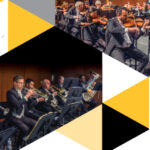Concert Review: Anna, Amadeus, & The Clock / October 12, 2019
By D. S. Crafts
Simms Center for the Performing Arts was the venue for a New Mexico Philharmonic concert of Mozart and Haydn this past Saturday. And it has proven to be an excellent house for the orchestra, neither too wet nor too dry in acoustic sonority.
The afternoon began with maestro Roberto Minczuk commanding thunderous sonorities from the orchestra, foreshadowing the gravity of the drama of Don Giovanni. The Overture bristled with musical dramatic tension, brought about by the juxtaposition of its highly memorable themes.
The Mozart continued with Ukranian-American pianist, and Olga Kern International Piano Competition Audience Award winner, Anna Dmytrenko taking the stage for the Piano Concerto No. 25 in C Major, K. 503. Mozart’s Concertos 21 and 23 get played almost to death (if anything but neglect could ever or did ever kill Mozart). It’s refreshing to hear one of the others. While the themes may be a tad less memorable, the charm of late Mozart is everywhere on brilliant display in No. 25.
Dmytrenko’s approach was both strong, decisive and full of visual panache, fully utilizing the rich sound of the Steinway grand. Yet still she brought her own personality into the grace of the music. She and Mr. Minczuk seemed commensurate in their extroverted understanding of the work, creating a bustling sense of enthusiasm and excitement– the kind of thrilling feeling rarely, if ever, found in our contemporary music. The final Allegretto sparkled expansively, even incorporating its two minutes of heart-piercing tenderness in the middle of the otherwise roaring movement.
Her encore, unannounced, was the Brahms Intermezzo in A major, Op. 118 No. 2.
After the break the orchestra took on Haydn’s Symphony No. 101, “The Clock,” part of his final group of symphonies for the London stage, and epitomizing its composer’s wit and elegance. The Adagio-Presto with its ever-variant second theme, set the table for a splendid performance with enough orchestral color and vivacity to attract even the most hard-core Romantics.
This symphony is of course most notable for its second movement, a musical, even comical portrayal of a ticking clock guiding us rhythmically through the course of the day. But then with a burst of sudden volume, the clock is transformed into a phantasmagorical episode straight out of golden-age cartoons. Eventually it settled back down into a somewhat normal clock, but we remain with the suspicion that this is far from just a simple time-keeper. The tick is now in the flute (Valerie Potter) and bassoon (Stefanie Przybylska) more than two octaves apart. This is one very strange clock.
In the Trio of the Menuetto, one of the composer’s longest middle movements, Haydn’s quaint musical joke came off nicely. The music is seemingly stuck on the tonic chord until with a final fury, like a cat, it bounds up and away. The finale filled the hall with a spirit of jubilation, an uninhibited delight in sheer orchestral virtuosity. At last, instead a simple return of the main theme, we were treated to a double fugue as recapitulation, the release of cumulative excitement that had built throughout the performance.



